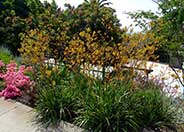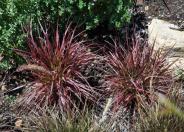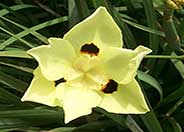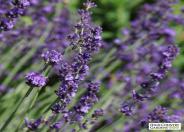
Common name:Kangaroo Paw 'Yellow'
Botanical name:Anigozanthos 'Yellow'
This herbaceous perennial can reach 4'-6' tall and 2'-3' wide. Kangaroo Paw has strap-like leaves and fuzzy tubular-shaped, yellow flowers that bloom in spring and fade as summer progresses. They can be used for cut or dried flowers. The flowers have nectar which attract hummingbirds. Kangaroo Paw does well in full sun and looks great in borders, mass plantings, and in pots. It can do well in drought tolerant conditions. It prefers sandy soil and deep, infrequent watering.

Common name:New Zealand Flax
Botanical name:Phormium tenax 'Atropurpureum'
Phormium tenax 'Atropurpureum' is an evergreen perennial. Big, dramatic plant composed of many swordlike, stiffly vertical leaves (9 ft. long, to 5 in. wide) in a fan pattern. Leaves are purple red. Flowers stems reach high above leaves, bearing clusters of 1-2 in. blossoms in dark red to yellow.

Common name:Fireworks Dwarf Fountain Grass
Botanical name:Pennisetum 'Fireworks'
Showy upright growing grass to 4 feet tall with leaf blades that are variegated with longitudinal stripes of white, green and burgundy, imparting a candy-cane-like appearance to the new foliage. As with the typical Fountain Grass (Pennisetum x advena 'Rubrum') it has purple tassels in late summer that rise above the foliage. The variegation fades in bright light and through the season.

Common name:California Poppy, Golden Poppy
Botanical name:Eschscholzia californica
This small annual (sometimes acts as a perennial) plant will grow to less than 1' tall and has light, small blue/green leaves with gold and orange flowers that bloom in spring and summer.

Common name:Yellow Moraea, Fortnight Lily
Botanical name:Dietes bicolor
This clumping perennial iris relative stands 3-4' high. It has light yellow iris-like flowers with maroon blotches that are about 2" wide. It performs best in full sun and in soil with good drainage.

Common name:Sharon Roberts English Lavender
Botanical name:Lavandula angustifolia 'Sharon Roberts'
Lavandula angustifolia Sharon Roberts is an outstanding twice blooming English Lavender with spikes of bicolored lavender-blue and gray-green foliage. This intensely fragrant English Lavender can bloom twice annually when promptly deadheaded after its early summer flush of flowers. A Nichols Garden Nursery introduction, it has gorgeous deep lavender flowers and dark blue calyxes on medium length flower spikes. In the garden 'Sharon Roberts' thin flower spikes give the plant a finely textured appearance that is distinct from other English Lavender types like 'Graves' and 'Hidcote Superior'. (Cutting propagated.) Lavender are sun-loving plants that thrive in hot weather and grow best in arid climates. Lavender plants will be taller and wider in mild winter, hot summer climates. The same varieties when grown in cold (zone 5-6) winter climates tend to be more compact. Lavender plants require two-to-three growing seasons to reach mature size. Plant in full sun with good air circulation. Plant into well drained soil. Compost-enriched garden loam is alright in drier climates, sandy or gravel soil is best in moister climates. Heavy, poorly-drained clay soils will be fatal. Select a raised or sloped bed, or a planting site against a hot wall or along a cement/asphalt walk or driveway where the reflected heat keeps growing conditions hotter and drier. New transplants need regular watering. Don't let the plants get too dry. Supplemental watering can be greatly reduced the second growing season as the plants become established. When using drip irrigation, place the emitter off to the side of the plant, not right on the root ball to avoid overwatering of mature plants. Fertilize once annually in the fall with a top dressing of Yum Yum Mix. Mulch with gravel or pine needles in arid climates. In moister climates mulching with gravel will protect the crown from excessive moisture and soil splashed onto the foliage.
Designer:
Photographer: Vicki Anderson
Practice grass-cycling by leaving short grass clippings on lawns after mowing, so that nutrients and organic matter are returned to the soil.
Remove irrigation water and fertilizer from areas where you don't want weeds to grow.